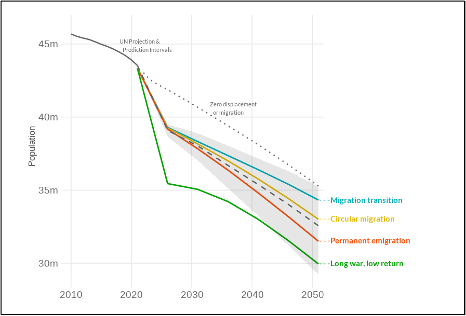
On 24 February 2023, Russia’s war against Ukraine reached its one-year mark. In the space of one year, many Ukrainians had to flee their country, which lead to the fastest and largest displacement of people in Europe since the Second World War.
It is estimated that by the end of January 2023, there were around 5.3 million people displaced internally across Ukraine, while approximately 7 million had fled abroad with around 4 million to the EU.
This means that the war has displaced between 25% and 30% of the entire Ukrainian population within and outside Ukraine.
The Ukrainian population was already shrinking rapidly before the war due to low birth rates, high levels of mortality and high emigration rates.
In a new report, scientists from the Joint Research Centre (JRC) estimate that the country could be losing over a third of its population by 2052.
Four what-if scenarios on Ukraine’s demographic future
The researchers developed four hypothetical scenarios with different assumptions on the length of the war, level of displacement and longer-term migration patterns, including returns after the war.
The study illustrates how the forced displacement and long-term migration patterns impact Ukraine’s future population size.
In all four scenarios, the population of Ukraine is projected to further decline until 2052. In the most pessimistic scenario, which foresees a long war and a low number of Ukrainian nationals returning after the war, the results project a 31% decline of the population by 2052.
Even in an optimistic scenario where Ukraine recovers from the war quickly and becomes a country with more inward than outward migration, the results suggest a population decline by 21%.
The study indicates that the war and the resulting displacement exacerbate Ukraine’s population decline and ageing, with drastic changes to the population structure - in particular the younger age groups.
One year of temporary protection for those fleeing the war in Ukraine
The latest edition of the Atlas of Migration contains a thematic section on displacement patterns from Ukraine since the start of the Russian invasion.
It analyses the scale of the displacement from Ukraine to the EU, the distribution of the people fleeing Ukraine across the Member States, as well as the demographic characteristics of the persons receiving temporary protection.
The Temporary Protection Directive (TPD), activated just one week after the start of the war, was a key component of the EU response to Russia’s unprovoked aggression against Ukraine.
It gave millions of displaced persons fleeing Ukraine immediate access to the labour market, education, healthcare and accommodation.
Today, more than four million people benefit from temporary protection in Europe. Of these, more than one third are children, whose protection remains a critical priority.
At the end of 2022, the largest number of beneficiaries in the EU was registered in Germany and Poland (with almost one million each – equal to 50% of all beneficiaries in the EU) and Czechia (435 thousand – equal to 11% of all beneficiaries).
In all EU countries, more than 50% of the beneficiaries of temporary protection are between 18 and 65 years old. Around 36% are 18 years old or younger, and 24% between 18 and 34. Almost 8 in 10 of the beneficiaries of temporary protection who are over 18 are women.
One year later, the Temporary Protection Directive is a remarkable testament to EU unity and its solidarity with the people of Ukraine.
Today, the Commission also published a Communication on temporary protection for people fleeing the Russian aggression against Ukraine. The Communication looks at the measures taken over the past year and at the areas where further work is needed to overcome remaining barriers to accessing the rights granted by temporary protection.
Related links
Ukraine’s population future after the Russian invasion
Atlas of Migration - section on displacement from Ukraine
Press release: One year of the implementation of the Temporary Protection Directive
Migration management: people fleeing the war in Ukraine
Thanks to temporary protection in the EU, Tonya finds hope
KCMD - Knowledge Centre on Migration and Demography
Details
- Publication date
- 8 March 2023
- Author
- Joint Research Centre
- JRC portfolios





